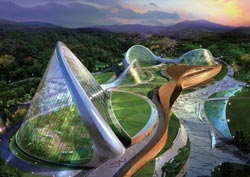DuPont Glass Laminating Solutions Announces Commercial Launch of New Safety Glass Interlayer for High UV Transmission

Samoo Architects & Engineers’ rendering of South Korea’s National Ecological Institute “Ecorium” project.<br>
“Bringing full-spectrum light through laminated glass is proving attractive to botanists and other life science professionals,” said DuPont Advanced Interlayer Business Director Ron Hull. “Our decision to fully commercialize and promote SentryGlas® N-UV ionoplast interlayer for this market reflects growing demand from around the world for this unique product.”
The latest project specified in high-UV-transmissive DuPont interlayer is South Korea's National Ecological Institute (NEI) “Ecorium” project, a 33,090-square-meter, multi-domed, multi-climate-zone nature reserve and sustainability-minded study center under construction in Seocheon-gun.
Past proof-of-concept projects include a popular and pioneering indoor Amazonian rainforest exhibit at the CosmoCaixa science museum in Barcelona; the world-famous “Tropenhaus” rare species botanical garden in Berlin, Germany; and a bottlenose dolphin rehabilitation center in Atlanta, Georgia.
For each project, DuPont specially manufactured its high-strength ionoplast interlayer without using UV blockers, allowing construction of laminated glass panels with improved transmission of shorter-wavelength UV-A and UV-B ultraviolet light. While invisible to humans, UV light is critically needed by many terrestrial and aquatic species for food identification, mating and display, proper growth and good health in environments as close as possible to their normal outdoor habitat.
Most architectural laminated glass includes UV blockers to protect interior fabrics and furnishings from discoloration and to avoid prolonged human skin exposure to the UV light rays. Compared with other interlayers available to the laminated glass industry, DuPont™ SentryGlas® N-UV is not cross-linked or cured, relying instead on intrinsic ionoplast stability to resist degradation or loss of clarity from extended exposure to sunlight.
Like normal ionoplast sheet, DuPont™ SentryGlas® N-UV offers up to 100 times the stiffness and 5 times the toughness of traditional safety glass interlayers, allowing for larger glass spans. This can further improve natural light transmission when used in combination with high-transmissivity glass. Structural engineering advantages of SentryGlas® interlayer often allow for thinner glass and minimally supported glazing. The interlayer's outstanding resistance to moisture ingress and chemical attack make it ideal for open-edged designs, even in warm, humid environments.
SentryGlas® N-UV interlayer is available in sheet form, in 1.52-mm (0.060-in.) thickness. To help life science professionals and others explore product application ideas, DuPont has sample interlayer sheets available immediately for lamination and testing with user-specified glass for envisioned projects.
For additional SentryGlas® N-UV product information, including ultraviolet light transmission curves, visit sentryglas.com.
DuPont (NYSE: DD) has been bringing world-class science and engineering to the global marketplace in the form of innovative products, materials, and services since 1802. The company believes that by collaborating with customers, governments, NGOs, and thought leaders we can help find solutions to such global challenges as providing enough healthy food for people everywhere, decreasing dependence on fossil fuels, and protecting life and the environment. For additional information about DuPont and its commitment to inclusive innovation, please visit www.dupont.com.
The DuPont Oval logo, DuPont™, The miracles of science™, and SentryGlas® are trademarks or registered trademarks of DuPont or its affiliates.
Contact:
Birgit Radlinger
Birgit.radlinger@dupont.com
Media Contact
More Information:
http://www.dupont.comAll latest news from the category: Architecture and Construction
Newest articles

NASA: Mystery of life’s handedness deepens
The mystery of why life uses molecules with specific orientations has deepened with a NASA-funded discovery that RNA — a key molecule thought to have potentially held the instructions for…

What are the effects of historic lithium mining on water quality?
Study reveals low levels of common contaminants but high levels of other elements in waters associated with an abandoned lithium mine. Lithium ore and mining waste from a historic lithium…

Quantum-inspired design boosts efficiency of heat-to-electricity conversion
Rice engineers take unconventional route to improving thermophotovoltaic systems. Researchers at Rice University have found a new way to improve a key element of thermophotovoltaic (TPV) systems, which convert heat…



